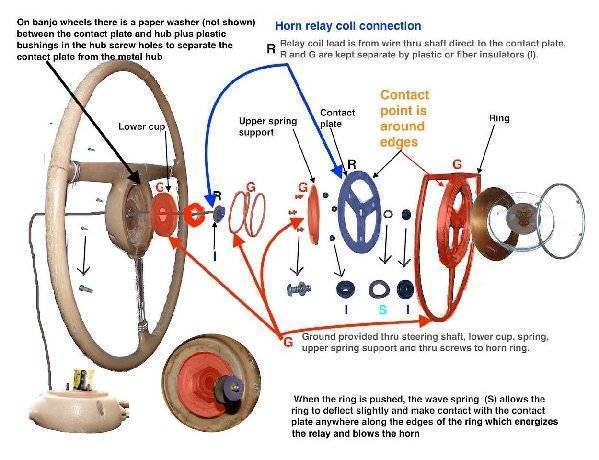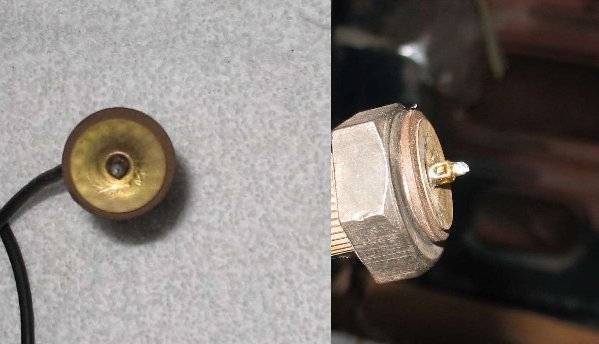|
Re: Steering wheel horn switch veiw
|
||||
|---|---|---|---|---|
|
Forum Ambassador
|
It is a copper or bronze disc with a slight belled shape which keeps the disc from deforming under pressure. It rests on a larger fiber insulating washer which keeps the disc from touching the nut and steering shaft. When the wheel is assembled the disc makes constant contact with the heavy mounting plate which holds the horn ring assy to the wheel.
Here is a drawing done by Wes Boyer showing an exploded view of the assembly. I added the electrical path, items in red are at ground or earth potential and the item in blue is the mounting plate which presses directly against the wire end and disc. The pieces are separated by insulating washers when screwed together. There is a very tiny gap between the heavy mounting or contact plate and the circumference of the horn ring. When the horn ring is pushed the outer edge of the contact plate and inner edge of the horn ring make contact blowing the horn.
Posted on: 2018/1/8 9:43
|
|||
|
Howard
|
||||
|
||||
|
Re: Steering wheel horn switch veiw
|
||||
|---|---|---|---|---|
|
Home away from home
|
Also you might want to checkout my video on reassembling a K steering wheel, about the same except you don't need the insulator when mounting the Horn Ring assembly. This video also has an ohm checkout to show how to check the contacts work before install the assembly.
youtube.com/watch?v=6pWj4FiyxMs&t=17s Wes
Posted on: 2018/1/8 18:24
|
|||
|
||||
|
Re: Steering wheel horn switch veiw
|
||||
|---|---|---|---|---|
|
Home away from home

|
It looks like one can test the horns with the steering wheel removed by turning on the ignition and touching a wire between the center contact "i" and the nut g. Is that correct?
On the 47 Custom super clipper, As I recall the power to the horn relay comes from a wire connected to upper right screw terminal on the solenoid. My horn was not working and I think this was the problem. It was not wired correctly. Have not done this yet.
Posted on: 2018/1/9 15:00
|
|||
|
||||
|
Re: Steering wheel horn switch veiw
|
||||
|---|---|---|---|---|
|
Forum Ambassador
|
Yes, you can test the horns as you described. If the car is wired per original as long as the battery is connected it should not even need the key on.
The horn relay needs a ground to energize and has 3 terminals labeled B for battery, H for horns and S for switch (the wire in steering wheel). The terminal location on the relay could be different depending on the brand. The letters may be very faint and if the B and H marking is not clear the wires can be accidentally reversed. No damage will happen but obviously the horns will not work. The battery wire is usually the thickest and comes from the same solenoid terminal the battery connects to. As an added issue there are ordinary power relays of that period which look identical to horn relays. They are labeled differently and need a voltage to energize. If one of those gets installed for the horns it causes all kinds of confusion.
Posted on: 2018/1/9 15:14
|
|||
|
Howard
|
||||
|
||||
|
Re: Steering wheel horn switch veiw
|
||||
|---|---|---|---|---|
|
Home away from home
|
I'll need a new horn wire on my Packard, but it is a 1951 model, so it would be different than this.
John
Posted on: 2018/1/9 21:48
|
|||
|
||||
|
Re: Steering wheel horn switch veiw
|
||||
|---|---|---|---|---|
|
Forum Ambassador
|
The illustration is of a 47. The 48-54 horn ring is shaped differently and the entire assy mounts a bit differently to the wheel but some of the parts and the operation and electrical path is essentially the same. The copper or bronze terminal disc attached to the wire at the wheel is the same but the terminal on the bottom that connects to the loom is different..
Posted on: 2018/1/9 22:46
|
|||
|
Howard
|
||||
|
||||


 (125.68 KB)
(125.68 KB)








